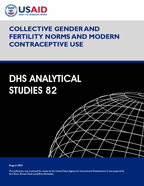There is no printed copy available to order.
Abstract:
Evidence shows that collective fertility and gender norms affect the use of contraceptives, especially women’s use of modern contraception. However, the association of collective fertility and gender norms on men’s modern contraceptive use and how those associations differ between women and men have largely not been explored. In addition, the evidence on the differential association of those collective fertility and gender norms among peer and non-peer age groups on modern contraceptive use is mainly qualitative and limited in scope. In this study, we examine associations between collective gender and fertility norms and individual use of modern contraceptives. The study further explores whether these associations differ for men and women, within age-based peer groups, and across regions within the same country. Data for this study came from the most recent DHS surveys in Nepal (2016), Nigeria (2018), and Zambia (2018). The measures of collective fertility and gender norms were community-level measures of the ideal number of children, contraceptive decisionmaking, women’s empowerment, and men’s beliefs about contraceptives and promiscuity. We used multilevel logistic regression to model the effect of collective fertility and gender norms on women and men’s modern contraceptive use and controlled for individual and community-level covariates. We used the proportional reduction in variance measure to estimate the proportion of decrease in community-level variation for the model with the addition of covariates. Our findings suggest that there are differences in the effects of collective norms on men’s use of modern contraceptives compared to women’s. We find that in all three countries, women’s collective fertility norms, as measured by the average number of ideal children, has a significantly negative effect on women’s modern contraceptive use. Most community-level effects were heterogeneous on individual modern contraceptive use across the three countries. Although this study was focused on the influence of the community-level norms, two individual-level characteristics, desire for children soon and the woman being involved in contraceptive decisionmaking, were associated with women’s use of modern contraception in all three countries. Desire for a child soon was associated with men’s report of modern contraceptive use in all countries. In addition, we did not find a stronger effect of collective norms among age peer groups on individual behavior. In each country, the proportional reduction in variance was either the same or smaller for men compared to the women for each of the full models. These findings show that while collective norms have an important influence on modern contraceptive use, more research is needed to identify, understand, and measure these norms, especially for men.
 Collective Gender and Fertility Norms and Modern Contraceptive Use (PDF, 3400K)
Collective Gender and Fertility Norms and Modern Contraceptive Use (PDF, 3400K)
